INDIAN ARMED FORCES CHIEFS ON
OUR RELENTLESS AND FOCUSED PUBLISHING EFFORTS

SP Guide Publications puts forth a well compiled articulation of issues, pursuits and accomplishments of the Indian Army, over the years

I am confident that SP Guide Publications would continue to inform, inspire and influence.

My compliments to SP Guide Publications for informative and credible reportage on contemporary aerospace issues over the past six decades.
Super Hornet — Built for Air Superiority
The F/A-18 Block III Super Hornet is the newest highly capable, affordable and available tactical aircraft in US Navy inventory. Boeing has developed the Block III Super Hornet as the US Navy’s most advanced frontline carrier-based, multi-role strike fighter available today to complement existing and future air wing capabilities.

F/A-18E/F Super Hornet is the US Navy’s frontline carrier-based strike fighter. It is the most advanced multi-role strike fighter available today and for the foreseeable future, the Super Hornet has the capability, flexibility and performance necessary to modernise the air or naval aviation forces of any country. The Super Hornet is the backbone of the US Navy carrier air wing now and for decades to come.
The combat-proven Super Hornet delivers cutting-edge, next-generation multi-role strike fighter capability, outdistancing current and emerging threats well into the future. The Super Hornet has the capability, flexibility and performance necessary to modernise the air or naval aviation forces of any country.
Two Super Hornet versions—the single-seat E model and the two-seat F model—are in production today and in service with the US Navy. Both are true multi-role aircraft, able to perform virtually every mission in the tactical spectrum, including air superiority, day/night strike with precision-guided weapons, fighter escort, close air support, suppression of enemy air defences, maritime strike, reconnaissance, forward air control and tanker missions.
BOEING F/A-18 MILESTONES
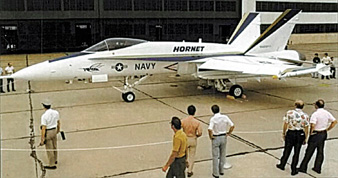 | 1978The F/A-18 Hornet completed its first flight in 1978 |
1983-84Hornets entered operational service with the Marine Corps in 1983 and the US Navy in 1984 | 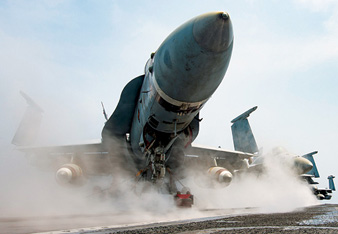 |
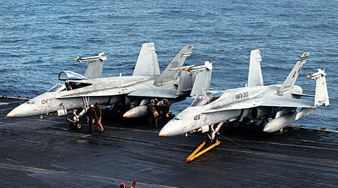 | 1986In 1986, Hornets on the USS Coral Sea flew their first combat missions |
1991During the 1991 Persian Gulf War, while performing an air-to-ground mission, Hornets switched to fighter mode and destroyed two Iraqi MiG-21s in air-to-air combat | 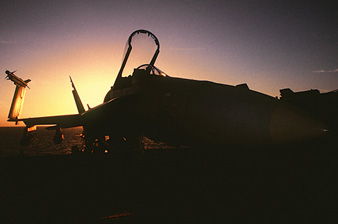 |
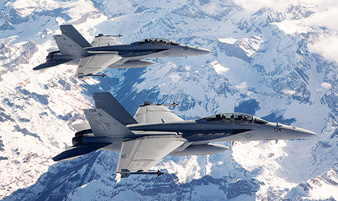 | 1995The F/A-18E/F Super Hornet made its first flight in November 1995 |
1999The F/A-18E/F entered operational service with the US Navy in 1999 | 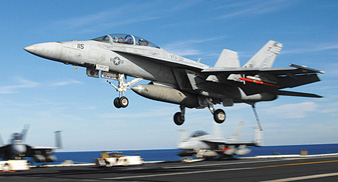 |
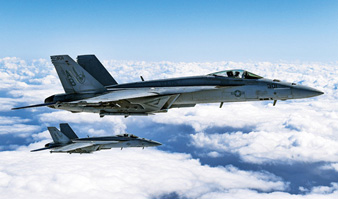 | 2001The first operational F/A-18 E/F Super Hornet squadron formed in June 2001 |
2002Deployed into combat aboard the USS Abraham Lincoln (CVN 72) in July 2002 | 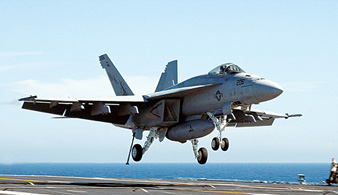 |
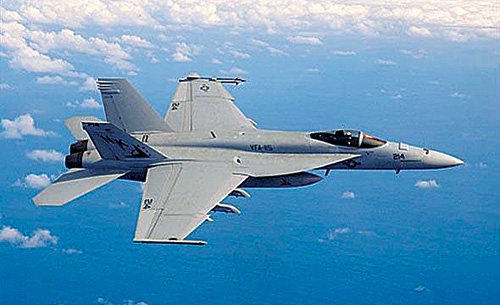 | 2005In April 2005, Boeing delivered the first Block II Super Hornet, complete with the world’s first tactical multi-mode AESA radar |
2008In 2008, the EA-18G Growler joined the Navy’s aircraft fleet. A Super Hornet derivative, the EA-18G provides tactical jamming and electronic protection | 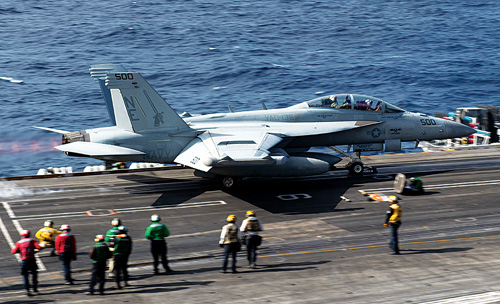 |
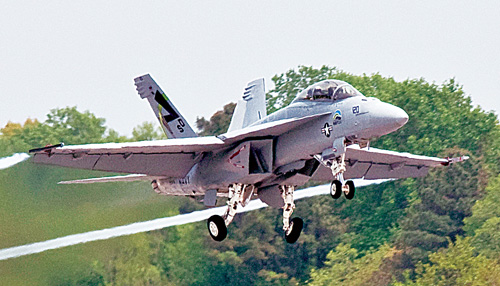 | 2010On April 22, 2010 F/A-18F Super Hornet took off powered by a sustainable biofuel blend of 50 per cent camelina and 50 per cent JP-5 aviation fuel |
2020The final F/A-18E/F Block II production aircraft was delivered to the Service in April 2020 | 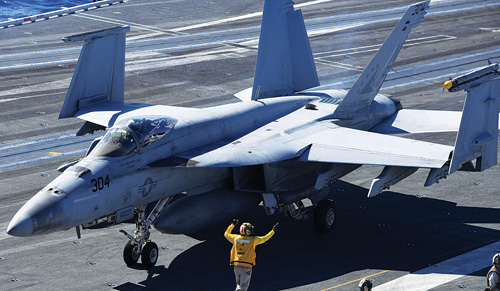 |
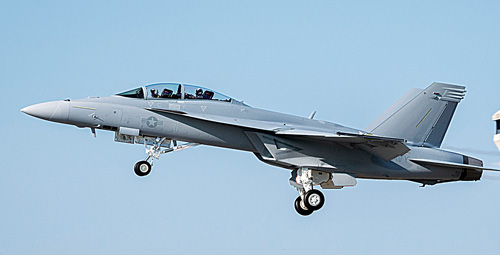 | 2021In August/September, 2021 Boeing delivered the first of 78 contracted Block III F/A-18 Super Hornets to the US Navy |
A comprehensive spiral development design concept — including the addition of the APG-79 active electronically scanned array (AESA) radar — offers continuously improving overall mission capability and supportability. Other recently incorporated upgrades include an advanced targeting forward looking infrared (ATFLIR), joint-helmet mounted cueing system (JHMCS), multifunctional information distribution system (MIDS), and an advanced aft crew station.
BACKGROUND
The F/A-18 Hornet completed its first flight in 1978 and entered operational service with the Marine Corps in 1983 and the US Navy in 1984. The Hornet replaced the F-4 Fantom and the A-7 Corsair.
The F/A-18A and C are single seat aircraft, while the F/A-18B and D are two seaters. The B model is primarily used for training, while the F/A-18A+ and C/D models are used for attack, tactical air control, and forward air control and reconnaissance missions. There have been several block upgrades to the Hornet for enhanced capabilities throughout the platform’s service life.
GENERAL SPECIFICATIONS: F/A-18 SUPER HORNET, E/F MODELS
| In-Service | Navy and Marine Corps |
| Primary Function | Multi-role attack and fighter aircraft |
| Unit Cost | $67.4 million (FY21) |
| Propulsion | Two F414-GE-400 turbofan engines. 22,000 pounds (9,977 kg) static thrust per engine |
| Length | 60.3 feet (18.5 meters) |
| Height | 16 feet (4.87 meters) |
| Wingspan | 44.9 feet (13.68 meters) |
| Weight | Maximum Take Off Gross Weight is 66,000 pounds (29,932 kg) |
| Airspeed | Mach 1.8+ |
| Ceiling | 50,000+ feet |
| Range | Combat: 1,275 nautical miles (2,346 kilometers), clean plus two AIM-9s Ferry: 1,660 nautical miles (3,054 kilometers), two AIM-9s, three 480 gallon tanks retained |
| Crew | A, C and E models: One; B, D and F models: Two |
| Armament | One M61A1/A2 Vulcan 20mm cannon; AIM 9 Sidewinder, AIM-9X (projected), AIM 7 Sparrow, AIM-120 AMRAAM, Harpoon, Harm, SLAM, SLAM-ER (projected), Maverick missiles; Joint Stand-Off Weapon (JSOW); Joint Direct Attack Munition (JDAM); Data Link Pod; Paveway Laser Guided Bomb; various general purpose bombs, mines and rockets. |
Source: US Navy
Production of C and D models ended in 2000, with the last delivery of an F/A-18D to the US Marine Corps occurring in the summer of the same year. In April 2018, the US Navy announced retirement of the F/A-18C from combat roles. The F/A-18 E and F Super Hornet were rolled out at McDonnell Douglas (now a part of Boeing) in 1995. The E is a single seat and the F is a twoseater. The dual-seat variant serves as a trainer in addition to bringing added mission capacity on deployment by facilitating shared workload.
While substantially larger than its predecessor, the F/A-18 Hornet, at roughly 7,000 pounds heavier, with a 50 per cent higher range, the Super Hornet delivered with fewer parts and lower maintenance demands.
The first operational cruise of Super Hornet, F/A-18 E, was with VFA-115 onboard the USS Abraham Lincoln (CVN 72) in July 2002, and initial combat action occurred in November of the same year, when they participated in a strike on hostile targets in the “no-fly” zone in Iraq.
The jet’s robust airframe was built with an open mission systems architecture, enabling ease of integration for new weapons and technology systems. Through incremental block upgrades, the Super Hornet has proven adaptable and capable of keeping pace with adversaries in today’s dynamic combat environment by striving to continually deliver increased lethality and mission flexibility. Block II production incorporated the Active Electronically Scanned Array (AESA) radar, improved sensors and avionics, increased range, and capability to employ an arsenal of precision weapons.
The latest iteration, Block III, delivers increased service life of 10,000 flight hours and reduced radar signature, accompanied by a new avionics suite that brings the Common Tactical Picture into the cockpit; an advanced cockpit system, with large touchscreen displays for improved user interface; and more powerful computing through the Distributed Targeting Processor Network and Tactical Targeting Network Technology. The F/A-18 Block III Super Hornet will undergo comprehensive testing by the US Navy prior to production and operational service.
F/A-18E/F SUPER HORNET
F/A-18E/F Super Hornet entered fleet service in 1999, as the replacement for the F-14 Tomcat. The Super Hornet is the second major model upgrade since the inception of the F/A-18 aircraft programme highly capable across the full mission spectrum: air superiority, fighter escort, reconnaissance, aerial refueling, close air support, air defence suppression and day/night precision strike. The single-seat F/A-18E and the two-seat F/A-18F are high performance, twin-engine, mid-wing, and multi-mission tactical aircraft designed to replace the F/A-18C (single-seat) and F/A-18D (two-seat) aircraft as they reach the end of their service lives and retire.
COUNTRIES USING BOEING F/A-18
Besides the US Navy and the Marine Corps, the Hornet and Super Hornet comprise the aviation strike force for seven foreign customers including:
 Canada Canada |  Australia Australia |  Finland Finland |
 Kuwait Kuwait |  Malaysia Malaysia |  Spain Spain |
 Switzerland Switzerland |
Many more international partners like India have expressedinterest in these proven and versatile platforms.
The F/A-18E and F/A-18F are designed to meet current Navy fighter escort and interdiction mission requirements, to maintain F/A-18 fleet air defence and close air support roles, as well as an increasing range of missions, including Forward Air Controller (Airborne) and Aerial Tanking. F/A-18E/F enhancements include increased range and improved carrier suitability required for the F/A-18 to continue its key strike fighter role against the advanced threats of the 21st century.
F/A-18E/F Block II Super Hornet, in service since 2001, incorporated a number of capabilities-enhancing technologies over the course of the last 20 years, the Block II iteration has earned a reputation as the backbone of the Navy’s carrier air wing and a workhorse within the fleet. The final F/A-18E/F Block II production aircraft was delivered to the Service in April 2020.
The latest Block III upgrade, extends the platform’s service life and range, and incorporates an advanced cockpit system, reduced radar cross section and an advanced networking infrastructure. The Boeing Company delivered two F/A-18 Block III Super Hornet test jets to the US Navy in June 2020, with production to follow successful testing and a contract in place to provide 78 new-build F/A-18 Block III jets to the Service through 2024.
The US Navy’s Blue Angels Flight Demonstration Squadron has proudly flown the F/A-18 Hornet since 1984, but began transition to the F/A-18 Super Hornet in 2020.
The F/A-18 Hornet remains the workhorse of Marine Corps tactical aviation, and supports operational deployments around the globe. The Super Hornet builds on the F/A-18’s reputation as the Navy’s safest and most reliable tactical carrier aircraft, and the Navy has recognised it as a model acquisition programme. Since inception, the programme has remained on time, on weight and on cost.
The Navy and the Super Hornet industry team won the National Aeronautic Association’s 1999 Collier Award for designing, manufacturing, testing and introducing into service “the most capable and survivable carrier-based combat aircraft.”
F/A-18 BLOCK II SUPER HORNET: GAME CHANGER FOR INDIAN NAVY
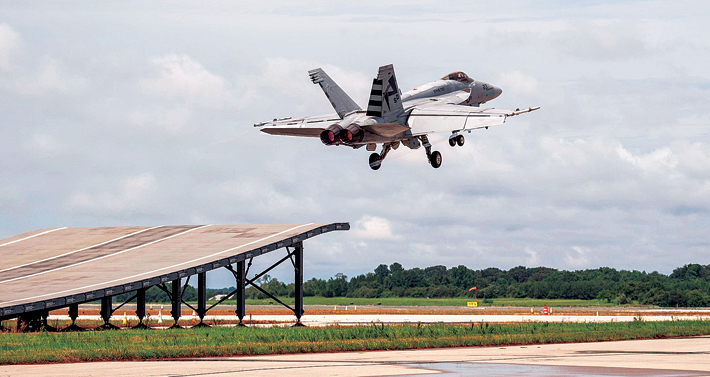
The F/A-18 Super Hornet Block II on offer to the Indian Navy is the world’s most advanced, combat proven, multi-role frontline naval fighter that offers unique and differentiated capabilities and full compatibility with Indian Navy carriers. Designed as a carrier-based fighter for high- loading, high stress operations, the F/A-18E/F Block III Super Hornet requires minimal support equipment and has the lowest cost per flight hour to operate with high mission readiness rates. As the US Navy’s frontline fighter with over 700 aircraft in operation around the world, the Block III Super Hornet offers opportunities for cooperation in naval aviation cooperation between the United States and India navies. The F/A-18E/F Block III Super Hornet can act as a force multiplier for the Indian Navy as it interfaces with assets such as the P-8I of the Indian Navy.
CARRIER COMPATIBILITY & INTERFACING WITH OTHER ASSETS
The F/A-18 Super Hornet has been designed and built for carrier operations, and is fully compliant with INS Vikramaditya and INS Vikrant aircraft carrier. In the last week of May 2022, two twin seater F/A-18 E/F Block III Super Hornets of Boeing landed at INS Hansa in Goa, for trials on the Indian Navy’s Shore Based Test Facility (SBTF). These aircraft underwent a series of trials and showcased their ski-jump and arresting gear landing ability as their compatibility to operate from India’s Aircraft Carriers. In 2020, Boeing F/A-18 has already demonstrated its ability to take off from Ski-jump at a shore-based facility located at Naval Air Station Patuxent River in Maryland, USA.
Boeing is offering F/A-18 Super Hornet in single-seater (E-Variant) and two-seater variant (F-Variant) to the Indian Navy, and both variants are carrier compatible to perform the full range of combat missions and can fully operate from the carrier deck. The two-seater is also a capable trainer aircraft - both ashore and carrier borne. This offers the Indian Navy flexibility and ensures that their air assets are never underutilised. The two-seater variant will allow Indian Navy to fly advanced missions from the carrier because of the second pilot on board. Also, carrier based naval aviation technologies related to Manned- Unmanned interface, can also be effectively operationalised through a two-seater version.
For years, Boeing teams have worked closely with the Indian Navy to analyse the overall compatibility of the F/A-18 Super Hornet Block III with Indian Navy’s current and future carriers. These complex studies involved STOBAR performance, arrested landings, aircraft spotting on the carrier deck and most importantly the fitting of the aircraft in the carrier lift and hangars. F/A-18 Super Hornet, with its wing-fold feature, offers a tried and tested, safe & practical solution for compatibility with the navy carriers.
The Super Hornet Block III on offer to the Indian Navy will come with advanced network architecture that will provide opportunities to interface seamlessly with other US origin assets including Indian Navy’s P-8Is. This will have the F/A-18 Super Hornet act as a force multiplier for the Indian Navy and increasing the type of missions they can execute.
SUPERIOR ECONOMICS
The F/A-18 Super Hornet has a long lifecycle built-in for future upgrades and enhancements, and depending on the Indian Navy’s requirements, Boeing’s ‘By India – For India’ sustainment program that is built on other successful sustainment programs that it is executing for the Indian Air Force and the Indian Navy today will allow for capabilities development in India to sustain the F/A-18 Super Hornet.
Powered by the GE F-414 engine, the F/A-18 Block III Super Hornet uses the same family of engines that is powering India’s indigenous Light Combat Aircraft (LCA); that has already been inducted by the Indian Air Force. The commonality in engines will create scale efficiencies for potential sustainment opportunities in the future.
The Super Hornet will also offer the Indian Navy the most economical path to get access to newer technologies compared to any other competitor. Due to the massive scale of the Super Hornets, Hornets in operation around the world, the cost of incorporating newly developed technologies will be very competitive.
ENHANCED NAVAL AVIATION COOPERATION BETWEEN THE US NAVY AND INDIAN NAVY
With the US Navy operating more than 700 F/A-18 Super Hornets and Growlers the induction of the Super Hornet by the Indian Navy would greatly promote naval aviation cooperation, sharing of operational best practices and enhance interoperability between the two navies. The F/A-18 Super Hornet also has the potential to create collaboration opportunities between the two navies for carrier integration, training, technology transfer, and so much more. Choosing this fighter will be an enabler to a secure Indo-Pacific region: Three out of the four countries that support a secure Indo-Pacific operate the P-8, and two out of the four countries operate the F/A-18.





